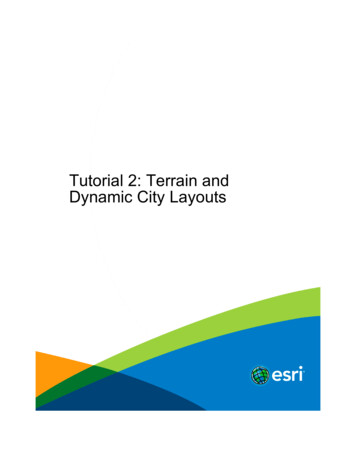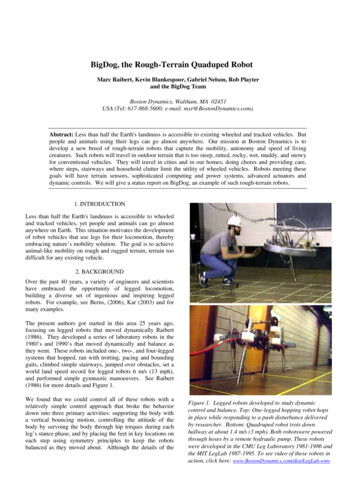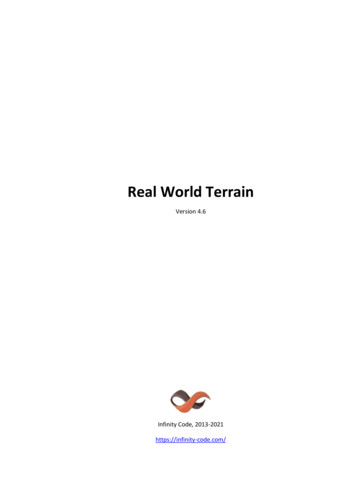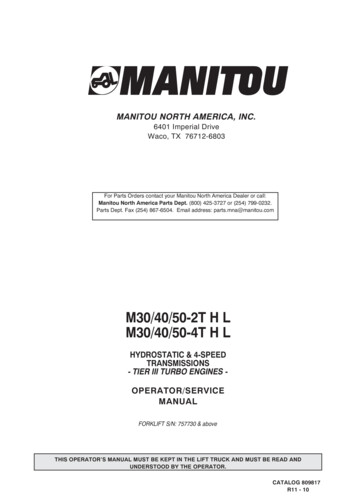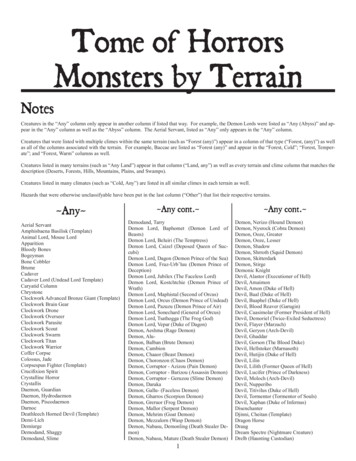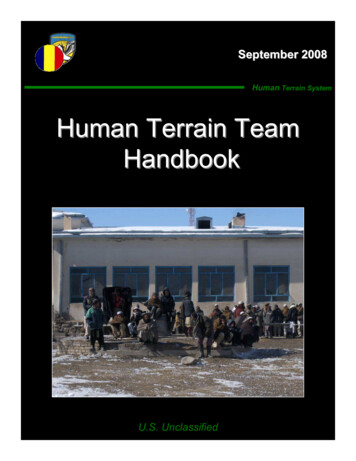
Transcription
September 2008Human Terrain SystemHuman Terrain TeamHandbookU.S. Unclassified
Human Terrain System731 McClellan Ave.Fort Leavenworth, KS66027U.S. Unclassified
Human Terrain Team HandbookTABLE OF CONTENTSI. INTRODUCTION2II. OVERVIEW4III. ORGANIZATION AND STRUCTURE11IV. METHODOLOGY49APPENDIX A - BEST PRACTICES OF AN HTT81APPENDIX B - BRIEFING91APPENDIX C - SAMPLE RESEARCH PLAN104APPENDIX D - SAMPLE INTERVIEW QUESTIONS113APPENDIX E - EXAMPLE REPORT FORMATS116APPENDIX F - COMMANDER FEEDBACK119AUTHOR – CPT NATHAN FINNEYCPT, ARHTS DOCTRINE DEVELOPMENT TEAM LEADERU.S. UNCLASSIFIED1
Human Terrain Team HandbookChapter 1Introduction“Understanding the effect of operations as seen through the lens ofthe [local] culture and psyche is the foremost planningconsideration for every operation.”- LTG Peter Chiarelli,Commanding General, Multi-National Corps-Iraq, 2006 - 2007Human Terrain Teams (HTTs) are five- to nine-person teamsdeployed by the Human Terrain System (HTS) to support fieldcommanders by filling their cultural knowledge gap in the currentoperating environment and providing cultural interpretations ofevents occurring within their area of operations. The team iscomposed of individuals with social science and operationalbackgrounds that are deployed with tactical and operational militaryunits to assist in bringing knowledge about the local population into acoherent analytic framework and build relationships with the localpower-brokers in order to provide advice and opportunities toCommanders and staffs in the field.HTTs are regionally-focused, modular special staff that bringscapabilities that exist outside of organic Battalion, BCT, and Divisionstructure. They deploy as trained and organized teams, attached toUSMC Regimental Combat Teams, Army Brigade Combat Teams,and Division, Corps, and Combined Joint Task Force, level HQs.Each team is recruited and trained for a specific region, thendeployed and embedded with their supported unit. The HTTs arecomprised of a mix of Soldiers and Department of the ArmyContractors that provide a mix of senior military specialists andacademicians with strong social sciences credentials. An HTTintegrates into the unit staff, conducts unclassified open-source andfield research, and provides operationally-relevant human terraininformation in support of the planning, preparation, execution andassessment of operations.A fundamental condition of irregular warfare and counter-insurgencyoperations is that the Commander and staff can no longer limit theirfocus to the traditional Mission, Enemy, Terrain and weather,friendly Troops and support available, and Time. The localpopulation in the area of conflict must be considered as a distinct andcritical aspect of the Commander’s assessment of the situation. ThisU.S. UNCLASSIFIED2
Human Terrain Team Handbookwas codified in Army doctrine with the publication of FM 3-0 in June2007, with modification of METT-T to METT-TC, adding “Civilconsiderations,” the nature of full spectrum operations requires commanders to assess theimpact of nonmilitary factors on operations. Because of this addedcomplexity, civil considerations has been added to the familiar METT-T toform METT-TC. All commanders use METT-TC to start their visualization.Staff estimates may address individual elements of, and add to, thecommander’s visualization.In an irregular warfare environment “Commanders and plannersrequire insight into cultures, perceptions, values, beliefs, interests,and decision-making processes of individuals and groups” and shouldbe evaluated according to their “society, social structure, culture,language, power and authority, and interests.” 1The human dimension is the very essence of irregular warfareenvironments. Understanding local cultural, political, social,economic, and religious factors is crucial to successful counterinsurgency and stability operations, and ultimately, to success in thewar on terror. In stability operations and irregular warfare, thehuman aspect of the environment becomes central to mission success.Information on social groups and their interests, beliefs, leaders, andthe drivers of individual and group behavior is needed to conducteffective counterinsurgency operations. The expertise for conductingresearch and analysis to provide valid and objective information onthese topics are highly specialized in the social sciences. Socialscience research of a host nation’s population produces a knowledgebase that is referred to as the Human Terrain, or “The element of theoperational environment encompassing the cultural, sociological,political and economic factors of the local population.” 2This handbook is designed to provide a base of knowledge for futureHuman Terrain Team members to understand and utilize theircapabilities, as well as learn from previous deployments of other teammembers in order to integrate them into their training and employingthem when in the field.12FM 3-24, December 2006Human Terrain System CONOP, July 2008.U.S. UNCLASSIFIED3
Human Terrain Team HandbookChapter 2OverviewThe Human Terrain Team MissionMission Statement - Conduct operationally-relevant, open-sourcesocial science research, and provide commanders and staffs at theBCT/RCT and Division levels with an embedded knowledgecapability, to establish a coherent, analytic cultural framework foroperational planning, decision-making, and assessment.There are three key points to the Human Terrain Team missionstatement. The first is social science research. HTTs are unique inthat they embed social scientists who are expert at developing andexecuting field research. The HTT takes the unit’s campaign planand develops a research design that accounts for the commander’sPIR and CCIR, as well as perceived gaps in the unit’s culturalknowledge. This research design identifies the knowledgerequirements that the team can then address through specific missionsamongst the population. The research methods used to illicit thisrequired human terrain information include classic anthropologicaland sociological methods such as semi-structured and open-endedinterviews, polling and surveys, text analysis, and participantobservation. Both qualitative and quantitative methodologies areused, based on the research required.Second is making the gathered data operationally-relevant. Thehuman terrain information gathered by the team through theexecution of their research design is analyzed and collated by theteam, but if it is not distributed and briefed in a relevant manner, it isworthless data. One of the key functions of the Team Leader andResearch Manager is to take that data from the social science researchand couch it in terms familiar to a military audience, making it notsignificantly time-consuming, and insure it is operationally-relevantto the unit’s operations and problem-set.Finally is creating an analytic cultural framework for operationalplanning, decision-making and assessment. The team must not onlyconduct relevant research and make it usable to the unit; they mustalso insure it is incorporated into the continuous planning processesU.S. UNCLASSIFIED4
Human Terrain Team Handbookconducted by the commander and staff. Human terrain information isof no use to the unit unless it is integrated into the continuousplanning and decision making processes. The team must be tied intoall planning processes, including relevant working groups,assessment boards, etc. that can utilize human terrain data and sociocultural awareness.Sources of Human Terrain InformationThere are many sourcesthat team members canleverage in order toascertain human terraininformation within theirarea of operations andsupport unit planning.These sources provide aframework for analysis andare a result from theculmination of study from avariety of sources and require assiduous persistence to maintain. Asound cultural, linguistic and historical understanding is the teams’foundation of understanding, but contemporary research andknowledge will place these understandings in their proper currentcontext. There is a degree of latitude in how the team maintains theirunderstanding of the human terrain, but the following are possiblesources (by no means exhaustive) they can turn to in order to remaincurrent in their regional and local situational awareness.Field Research through Unit Patrols/MissionsEngaging the locals andobserving their customs andhabits personally isindispensable to collectingaccurate data. There issome information that canonly be collected by theteam interacting in personwith the local residents. Theunit’s patrols and missionsinto the operatingU.S. UNCLASSIFIED5
Human Terrain Team Handbookenvironment are a prime opportunity for the HTT to collect thisinformation. Census type data that are relevant to the needs of theunit (unemployment, literacy, education, etc.) and local perceptions isinformation that can be very difficult to collect systematically indangerous areas and could be collected while on these missions.Additionally, the team will find that they are able to collect a greatdeal of unintended information as they make observations whileaccompanying the unit in the area. Collecting data and informationdirectly from the local residents will buttress the credibility of theiranalysis. Collecting data in this fashion will require that the teammembers be comfortable with interviewing techniques and the use ofinterpreters. Accompanying units on patrols will allow the HTA toknow, realistically, what information the soldiers, interpreters,auxiliary personnel, etc. have access to in order to generate questionsand avenues of exploitation for the unit themselves to pursue. Quiteoften soldiers find themselves idle, surrounded by local residents(some that know English), and not really sure how to take advantageof the opportunity because they don’t have any specific direction.The HTT will be able to draft up a reasonable list of questions for theunit to focus their attention on rather than discussing superfluousinformation.Local Unit ReportsThe supported unit generates a variety of reports articulating currentactivity in all phases of the unit’s operations: Intelligence updates,assessments, and traffic analyses; Human Intelligence (HUMINT)reports; Situation Reports (SITREPs) from the various branches(PSYOP, Civil Affairs, IQATF, etc.), the reports generated by theindividual units, Red Team assessments, and region/conflict-specificreports (i.e. Sectarian Report, host nation law enforcement evaluationreports, etc.) detail aspects of the conflict that are relevant to the unit.Much of the unit’s tasking will derive from the issues identified inthese reports and the HTT benefits from being familiar with theircontents to ask intelligent and informed questions when that taskingdoes come.News SourcesNews sources are an excellent way to stay abreast of local, regional,and international events, trends, and attitudes. There are a number ofways to acquire this information, from online news feeds to hardU.S. UNCLASSIFIED6
Human Terrain Team Handbookcopy subscriptions. There is a vast availability of news, and the HTTmay choose to sample sources from a variety of ideologies, formats,languages, to achieve their objective. A compilation of newssummaries is the most efficient means of assimilating a great deal ofinformation in a limited time. If an item seems particularly pertinentto the HTT’s Operational Environment (OE), they can devote moretime to it. Some regions locally produce a compilation of salientregional news items from Arab media and translate them into English(i.e. The Baghdad Mosquito). These products provide a convenientmeans for the team to remain current and understand regionalperceptions. When reviewing news items, team members shouldfocus their attention on specific issues and events. It may beworthwhile to compile a list of significant issues relating to their OEand the region and find news items that deal specifically with thoseissues. Certainly, new issues will arise and previously significantissues will become obsolete, but as the team’s time is limited in thisregard, only those items that directly pertain should be attended to.External Agency ReportsA number of research organizations, think tanks, NGOs and the U.S.government conduct analysis on topics of regional interest. Thesereports address a wide range of issues and are useful in consideringall factors that may influence local and regional perceptions andbehavior. Brookings, The Center for Strategic and InternationalStudies, Parameters, RAND, The Small Wars Journal, Long WarJournal, Foreign Policy, Strategic Studies Institute, CongressionalResearch Service, and the International Journal of Middle EastStudies are a sample of some of the organizations that conduct thisanalysis. Many of the aforementioned organizations conduct analysison issues spanning the globe, not just that pertinent to Iraq andAfghanistan. Several tiers of the American military in country alsoconduct on-site analysis, and much of this useful to the HTT.Unit and External Agency MeetingsMeetings provide an interface between organizations that are notarticulated or summarized in reports. This dialogue allows the team aglimpse at the unit’s priorities and operational evolution. The HTTcan use these opportunities to determine the kind of cultural analyticsupport the unit could benefit from. The units hold a variety ofmeetings that cover local governance, economics, security forces,U.S. UNCLASSIFIED7
Human Terrain Team Handbookintelligence updates, non-lethal targeting, and information operations.General knowledge of current status of these aspects of the conflictsround out the team’s situational awareness. Local meetings are also auseful source of situational awareness; teams may be able toaccompany units to attend these meetings as the units themselvesnormally attend. Meetings addressing essential services, security,reconciliation, the repatriation of Internally Displaced Persons(IDPs), local governance meetings, and business expos can providethe HTT with an understanding from the perspective of the localpopulation, facilitating the communication of this perspective in theiranalysis.Scholarly LiteratureThe team’s Social Scientist, through academic channels, may haveaccess to sites that store scholarly literature. This resource providesregional assessments and analyses conducted by academic specialists.This resource can best be used for historical context and long-termresearch, as scholarly literature is not necessarily the most currentinformation.Debriefing/InterviewsThe HTT will not be able to participate in every worthwhile patrol togather the information they may need to support their research and itwill be necessary to acquire that information from garrisoned unitsand individuals. The unit staff themselves have some of theinformation the HTT needs to answer their research questions. Manytimes these individuals have information they do not considerparticularly valuable, or they never think to report because it is notindividually relevant to anything. Gathered properly, and from theright people, this information paints a comprehensive picture of theoperating environment.Organic ResourcesA variety of resources are available to the HTT within the unit theysupports. The unit’s branches, offices, and subordinate units are ableto provide many answers to the questions the team need answered.These offices will have compiled historical data for their respectiveareas and frequently the team will need to go no further to collect therequired information. Some of these attached or subordinate unitsU.S. UNCLASSIFIED8
Human Terrain Team Handbookconduct patrols among the local population regularly and are able toescort team members or will have the information already. Theseresources include Civil Affairs (CA), Psychological Operations(PSYOP), Information Operations (IO), Embedded ProvincialReconstruction Teams (ePRT), the unit assisting the security forces inforensic matters, United States Agency for InternationalDevelopment (USAID), Military Training Teams (MTT), NationalPolice Training/Transition Teams (NPTT), specialized branches (theReconciliation Officer, the contracts officer, etc.), interpreters, andother specialized military and governmental offices in the region.Upon receipt of tasking, the HTT will determine which, if any, ofthese resources could be solicited to satisfy the tasking requirements.Local ResourcesThe team will also have access to a number of local organizations,individuals, and offices from which they will be able to gatherinformation. As American forces continue to engage the localpopulation, individuals and organizations will step forward tofacilitate their efforts. Individuals from government offices,businesses, law enforcement and military units, communityorganizations, contractors, etc. may be able to provide the HTT withtheir information collection. The nature of the relationships betweenAmerican forces and the local population will differ from area to areaand the team will need to assess these relationships prior toconsideration of their use as a source of information.Liaison with Subordinate UnitsThe HTT can establish extremely beneficial relationships withsubordinate units. These units have intimate, localized knowledge oftheir respective areas, and this information is often required inbroader assessments. Subordinate units tend to have greater need andmore appreciation for the services an HTT can provide and willgenerally ask for assistance or information more frequently. AsHTTs do not have their own transportation assets, these subordinateunits are necessary for the HTT to travel off military bases. The teammay want to take the opportunity to assess the cultural knowledgegaps and undeclared needs of the unit and offer their respectiveservices. The subordinate units, as they spend a significant portion oftheir time among the local population, can benefit from the kind ofcultural awareness training the HTT could provide. The moreU.S. UNCLASSIFIED9
Human Terrain Team Handbookexposure the unit has to the kind of information the team deemsimportant in the field, the more willing and proficient they willbecome in collecting similar information, for the benefit of the teamand for their own benefit.The structure of the team reflects the unique nature of a HumanTerrain Team and how they conduct research. Also, the way inwhich an HTT addresses and leverages the sources of human terraininformation is based on the organization of the team and each teammembers’ roles.U.S. UNCLASSIFIED10
Human Terrain Team HandbookChapter 3Organization and StructureThe Human Terrain Team consists of five to nine military andcivilian personnel. Each team will include at least one Team Leader,one Social Scientist, one Research Manager and two Human TerrainAnalysts. A more robust team is preferred, due to operationalconstraints and the need for the team to both take part in the planningand decision making processes at the unit headquarters and push teammembers out among the population to gather human terraininformation to feed that process. The optimum composition of theteam would include at least one member of the team will speak thelanguage of the area of operation, one member will be a subjectmatter expert of the area, and one team member will be a female (toallow the team access to the 50% of the population frequentlyoverlooked in military operations).Team LeaderSocial ScientistResearch ManagerResearch ManagerSocial ScientistHuman TerrainAnalystHuman TerrainAnalystHuman TerrainAnalystHuman TerrainAnalystFigure 1 - Human Terrain Team CompositionU.S. UNCLASSIFIED11
Human Terrain Team HandbookHuman Terrain Team Leader (TL)The Human Terrain Team Leader (TL) is the commander’sprincipal human terrain advisor. They are responsible for focusingand supervising the team’s efforts based on the unit’s needs andintegrating the collected information into military staff decisionmaking processes. At a minimum, the TL is an active duty or retiredmilitary officer with experience advising O-6/O-5 level commandersand has experience as a principal brigade or higher staff officer. Thekey task for a TL is to successfully integrate the HTT into the unit inan effective manner, becoming the commanders’ trusted advisor.Team Leader Mission Essential Task ListAct as the commander’s Human Terrain Advisor.Direct all aspects of HTT activities.Serve as the primary interface between the HTT and the unitcommander.Insure the integration of Human Terrain into the planning processes.Provide Human Terrain mapping and estimates to the commanderbefore analysis.Brief staff on pertinent cultural effects in the operating area.Evaluate the Human Terrain against friendly & enemy courses ofaction.Assist the BCT staff develop courses of action.Represent the Human Terrain during unit planning.Analyze orders to determine the commander’s intent in reference tothe Human Terrain.Approve and disseminate cultural products.Monitor team Requests for Research.Figure 2 - Team Leader METLSocial Scientist (SS)Purpose: The Social Scientist is the unique member of a HumanTerrain Team. They advise the commander and staff in all humanterrain matters, and in particular the research methods required tocollect that necessary information.Functions: The SS manages ethnographic and social-scienceresearch, tying the team’s research design with the unit’s campaigndesign or operational concept and conducts ethnographic and social-U.S. UNCLASSIFIED12
Human Terrain Team Handbookscience analysis based on information gathered. The SS is anacademically qualified (MA/PhD) cultural anthropologist,sociologist, international relations, political science, or economicsexpert.Duties, Tasks, Responsibilities: The SS assists the team and unit tocreate a Common Operating Picture in relation to the human terrain.They achieve this by using pattern analysis to detect underlyingcultural assumptions about the world and using cultural operationalknowledge to keep units away from mistaken policy and practice andprevent the misapplication of force. They also support thecommander's decision-making process by recommending options forthe use of non-lethal effects to build trust, form partnerships andapply informed cultural knowledge to problem solving and buildingsolutions, all while mapping the human terrain of the unit area ofoperations as well as the local populations.Social Scientist Mission Essential Task ListAdvise the HTT and staff on the cultural components of theenvironment.Conduct & manage ethnographic research and analysis.Participate in the planning processes.Coordinate the Cultural Preparation of the Environment and CulturalData Collection Activities.Analyze cultural data.Assist in the development of Information Operation Plans.Identify cultural data and knowledge gaps.Identify specified and implied cultural data requirements.Analyze the operating area against cultural data.Brief staff on pertinent cultural effects in the operating area.Assess other characteristics of the battlefield (leaders, population,demographics, social, ethnic, and religion, etc).Assess how the population sees the coalition and the adversary.Assess the local population’s interests and issues and what impactplanned activities might have.Identify areas of contention within society.Provide local area interpretation of collected human terraininformation.Organize and manage focus groups with locals.Figure 3 - Social Scientist METLU.S. UNCLASSIFIED13
Human Terrain Team HandbookResearch Manager (RM)Purpose: The Research Manager is an integral part of any HTS teamand is primarily responsible for knowledge management, informationtracking, product dissemination, research strategy development andimplementation, and developing data processing techniques andstandards.Functions: The RM works closely with the Social Scientist (SS) todevelop, draft, explain, and implement a research design/strategy fora given mission or research project. This is critical for a successfulmission and for good long-term continuity. The RM is alsoresponsible for information tracking and storage (e.g. Requests forResearch, final products, data files, field notes, etc.). This functionallows for information flow by developing standard operatingprocedures for official requests for information, data processing,compilation, and dissemination. Additionally, the RM works toincorporate cultural knowledge into the Brigade (BDE) or Battalion(BN) Staff.Duties, Tasks, Responsibilities: The Research Manager has manyduties, tasks, and responsibilities that cover a broad range ofcategories. The RM participation in mission planning is to develop,document, and integrate the research strategy into the missionactivities of the Human Terrain Team (HTT), and into that of the unitwith which the team will embed. The research plan is not a singleplan, but a series of contingencies. It is vital that contingencystrategies be developed because the mission and the researchopportunities can change without notice.The RM is involved in working groups, which gives HTT a voice andallows for the potential to help shape future operations by aiding inthe cultural preparation of the environment. The RM is involved inthese working groups based on his or her background, as well as fieldexperience. This assembly provides HTT an opportunity to interjectcultural knowledge into future operations across all lines ofoperations. It also provides an opportunity to established focus to theworking group. Small goals, with cultural influences in mind, can beestablished that will lead to the development of a sound foundation.The RM is not the only participant in these meetings, but is certainlyin the position to provide valued input. Additionally, by attendingthese meetings the RM can get a better understanding of the BDE’sU.S. UNCLASSIFIED14
Human Terrain Team Handbookintent and potentially discover new areas that demand research actionfrom the HTT.The processing, storing, disseminating, and tracking of data arecritical responsibilities of the RM. Developing standard operatingprocedures (SOP) for file management, data processing,dissemination, and tracking will allow the team to easily locatearchived information. These SOPs will also allow for smoother intrateam operations through uniformity. Additionally, the means bywhich these are accomplished may differ amongst HTSorganizations, but the importance is that each team has an SOP forthese actions.The RM should also design a means to capture team duties, roles, andactivities for continuity purposes. All team members may not alwaysbe present, which means that each person will acquire extra dutiesfrom other team positions. Thus, continuity and transfer ofknowledge is crucial to team success. Developing a Continuity Bookis a duty that must be created as soon as possible.The RM is also a potential collector of data from field research. Thismeans that he or she must become very familiar with the researchprocess and ethnographic interviewing. These skills are also vital inthe development of the research strategy.Research Manager Mission Essential Task ListIntegrate human terrain collection plan with unit intelligencecollection plan.Maintain the Human Terrain component of the Common OperatingPicture using the Cultural Preparation of the Environment.Develop Human Terrain Information Requirements.Secondary collector of human terrain data from coalition elements.Collect and develop operationally-relevant information pertaining tohuman terrain.Manage the team’s requests for assistance from Subject MatterExperts, the Reach-back Research Center, and in-theater resources.Analyze available sources of local cultural information.Figure 4 - Research Manager METLU.S. UNCLASSIFIED15
Human Terrain Team HandbookHuman Terrain Analyst (HTA)Purpose: The Human Terrain Analyst (HTA) is the Human TerrainTeam’s (HTT) cultural, regional, and in some cases, linguistic expert.Certain forbidding areas have been closed to direct social and culturalresearch for decades. The availability of social scientists withextensive field experience in these areas is presently lacking. Until atime when social science can be conducted more freely in regionswhere HTTs are deployed, the HTA supplements the SocialScientist’s methodological expertise with a cultural and regionalexpertise. The HTA provides the HTT a resource of situationalawareness and deeper understanding of how the culture influences thebattle space. The HTA’s primary function is data collection and theassessment and analysis of that data. This data and its subsequentanalysis support the Social Scientist in satisfying the requirements ofthe unit they support.Functions: Derived from unit and team-driven tasking, the HTAconducts open source research, interviews, debriefs, accompaniesunits on patrols, attends unit and local meetings, reads reports,engages with individuals of local influence, reviews scholarlyliterature, and any other means necessary to collect the informationrequired to satisfy the tasking. The HTA assesses this informationfor relevance; conducts analysis to extract themes and drawconclusions; and compiles it in a form that is sensible and usable tothe Social Scientist or unit. The HTA also advises and trains ascalled upon to do so.Role within the HTT StructureThe HTA assumes much of the duties pertaining to data collection,initial assessment, and analysis. The tasking is communicated to theHTA through the Research Manager. There will be occasions wherethe HTA will need to collaborate with the Social Scientist, the TeamLeader, and the Research Manager, but the HTA’s day-to-dayfunctions will require coordination with just the Research Manager.Team meetings will be the ideal vehicle for this collaboration and theHTA, Social Scientist, Team Leader, and Research Manager willwork together to formulate research and data collection plans.Among the different positions
human terrain team handbook u.s. unclassified 1 table of contents i. introduction 2 ii. overview 4 iii. organization and structure 11 iv. methodology 49 appendix a - best practices of an htt 81 appendix b - briefing 91 appendix c - sample research plan 104 appendix d - sample interview questions 113 appendix e - example report formats 116 appendix f - commander feedback 119
